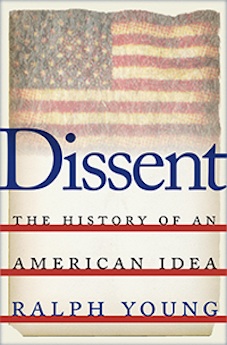Shortlisted for the 2016 Ralph Waldo Emerson Award
By Kayleigh Whitman
In a letter to James Madison in 1787, Thomas Jefferson famously wrote “I hold it that a little rebellion now and then is a good thing, and as necessary in the political world as storms in the physical.” Rebellion would keep democracy fresh and responsive to the people that participated. Ralph Young recognizes this sentiment in his book Dissent: The History of an American Idea.
After years of teaching “Dissent in America” at Temple University and having dynamic discussions on the same subject with different students and faculty, Young has put forth his case for the centrality of dissent in American history. In order to show the extent of the interrelatedness between conflict, protest and American identity, Dissent takes on the ambitious project of telling the nations entire history from early settlement through Occupy Wall Street using the voices of those Americans that did not see eye to eye. Rather than a story of a nation united in patriotic outlook, Dissent suggests that from the outset America has been a land of diverse opinions and more importantly, a population that was not afraid to voice their discontent.
The reframing of the accepted American narrative is one of the text’s greatest strengths. For example, Young begins by discussing the Christian Puritans that emigrated from England among tenement farmers and others hoping for economic prosperity. Stating that America is founded on a history of dissent seems fairly obvious considering most people are taught that the early settlers were literally fleeing their home country because they disagreed with the established religious order. However, that is not the story that Young wants to tell. In his telling the conflict that shaped America’s identity was not these people hoping to find religious freedom in a new world, but those that pushed back against the society that was created once these groups arrived in North America. Anne Hutchinson and Roger Williams assume the role of protagonist in Young’s story for they challenged the widely recognized religious beliefs of the early colonies. Both were banished. Subsequently, Hutchinson founded the Shaker religion and Williams Rhode Island. In Dissent’s telling America’s rebel past is no longer created by the search for religious freedom – it is rooted in the creative power of free thought and the courage to challenge accepted systems.
Another strength is Young’s attention to lesser-known protest movements, especially in the early part of American history. One of these is the campaign for Hispanic American rights led by Juan Cortina during the 1850s. After the U.S. failed to uphold the terms of the Mexican American War’s Peace Treaty, which guaranteed citizenship and rights to Mexicans living in ceded territory, Cortina and his followers began working outside of the law to achieve justice for the Tejanos and the Californios. Young also explores the often overlooked Utopian communities of the nineteenth century. As he explains to the reader these communities rejected established culture and adopted socialist and communal living environments that promoted good labor conditions, sharing of property, and expansion of the mind. These people were leaving accepted society to create a vision of America that worked for them.
As the text moves into later periods of American history, especially after the Civil War, the reader will be familiar with many of the dissent movements discussed: Labor Reform, Women’s Suffrage, Civil Rights, and the Environmental Movement. What Young does so well in the explanation of these more widely known movements is show the complexity that is present in dissent. If it is accepted that America’s history is full of diverse perspectives, then it is reasonable that the resulting movements themselves would experience the same. When explaining the protests against the Vietnam War, the text covers those who opposed the war from a radical political economic perspective such as the SDS, as well as those that took issue with the draft, and those that used the war as a catalyst to make war against “the system.” By explaining the varying perspectives, the reader has the good fortune to see how the individualism in American thought manifests even amongst those unified in motive.
While there is surprisingly limited sources and notes for a text this size, it does not take away from the intention of the book. Ralph Young is not attempting to bring revolutionary new material to the attention of the academic community. Rather, he has created a text for the public that reshapes its understanding of American history. Considering the current state of the American political and social climate, this book arrives at a seemingly perfect time. Young reflects on this in his conclusion. After outlining some of the more popular movements and social media activism, he makes a call to current dissenters to push themselves – to inspire a broader consciousness, demand responsibility in journalism, and question accepted authority. Only with an informed and engaged citizenry can the country maintain its intimate relationship with protest and fulfill its inherited destiny: evolution inspired by dissent.
Kayleigh Whitman (ΦBK, Florida State University, 2014) recently completed her Master’s degree in history at Brandeis University. Brandeis University is home to the Mu of Massachusetts Chapter of Phi Beta Kappa.




